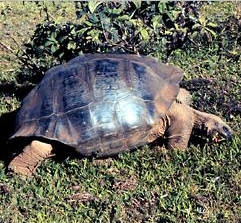Biology:Chelonoidis vandenburghi
| Chelonoidis vandenburghi | |
|---|---|

| |
| Chelonoidis vandenburghi | |
| Scientific classification | |
| Domain: | Eukaryota |
| Kingdom: | Animalia |
| Phylum: | Chordata |
| Class: | Reptilia |
| Order: | Testudines |
| Suborder: | Cryptodira |
| Superfamily: | Testudinoidea |
| Family: | Testudinidae |
| Genus: | Chelonoidis |
| Species: | C. vandenburghi
|
| Binomial name | |
| Chelonoidis vandenburghi (De Sola, 1930)
| |
| Synonyms | |
| |
Chelonoidis vandenburghi, also known as the Volcán Alcedo giant tortoise, the Alcedo Volcano giant tortoise or the Alcedo giant tortoise, is a species of giant tortoise endemic to the Galápagos archipelago in the equatorial eastern Pacific Ocean. The specific epithet vandenburghi honours American herpetologist John Van Denburgh.[2]
Taxonomy
This tortoise is a member of the Chelonoidis niger species complex, and is sometimes considered to be a subspecies of C. niger.[3]
Description
Male tortoises grow to about 129 cm and females to about 90 cm in length, with domed carapaces.[2]
Behaviour
The tortoises spend most of the day feeding, resting, or congregating in muddy pools. They sleep in the open at night. Adults migrate seasonally, travelling along the rim of the volcano's caldera and descending to the lower slopes to graze on new vegetation after wet season rains.[2]
Feeding
The tortoises feed on grass, leaves, forbs, sedges, fruit and lichens, obtaining water from their diet and pools of rainwater.[2]
Breeding
Male tortoises compete with each other by extending their necks, gaping, biting and pushing. They utter loud guttural noises while mating. Females start nesting in May and June at the end of the wet season, laying clutches of 6–26 eggs in soft soil. Juvenile tortoises tend to stay at lower, warmer, elevations for the first 10–15 years of their lives[2]
Distribution and habitat
The tortoise's range is limited to an area of 476 km2 on the Alcedo Volcano on the central part of Isabela Island. There it inhabits deciduous and evergreen forests as well as humid grassland. [2]
Conservation
The tortoise population is estimated to comprise some 6,300 individuals, a decline of 84% since 1840, and the species is considered to be Vulnerable. The tortoise population formerly suffered through predation and trampling of eggs and hatchlings, as well as habitat degradation, by introduced animals including pigs, donkeys and goats. Volcanic eruptions have also affected the tortoises and their habitat, with a major eruption of Alcedo 100,000 years ago thought to be the cause of the species' low genetic diversity.[2]
References
- ↑ Cayot, L.J., Gibbs, J.P., Tapia, W. & Caccone, A. (2018). "Volcán Alcedo Giant Tortoise". IUCN Red List of Threatened Species 2018. https://www.iucnredlist.org/species/9027/144766471. Retrieved 28 June 2021.
- ↑ 2.0 2.1 2.2 2.3 2.4 2.5 2.6 Arteaga, A; Bustamante, L; Vieira, J; Guayasamin, JM (2020). Reptiles of Ecuador: Life in the middle of the world. Quito: Universidad Tecnológica Indoamereica. https://www.tropicalherping.com/science/books/reptiles/reptiles_of_ecuador.html.
- ↑ "Chelonoidis vandenburghi (DESOLA, 1930)". Peter Uetz and Jakob Hallermann. https://reptile-database.reptarium.cz/species?genus=Chelonoidis&species=vandenburghi.
Wikidata ☰ Q12745316 entry


